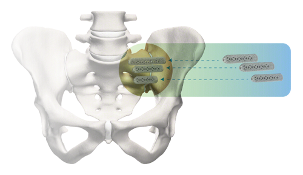The sacroiliac (SI) joint connects the spine to the pelvis and plays a crucial role in transferring weight from the upper body to the lower limbs. It can often be a source of lower back pain. Studies show that the SI joint is responsible for pain in 15-30% of people with chronic lower back pain.1-4 Additionally, up to 43% of patients who experience new or continued lower back pain after lumbar fusion surgery report the SI joint as the cause.5
The sacroiliac joint (SI joint) is located in the pelvis; it links the iliac bones (pelvis) to the sacrum (lowest part of the spine above the tailbone). It is an essential component for energy transfer between the legs and the torso.

The SI joint is the link between the ilium in the pelvis to the sacrum, which is the lowest part of the spine above the tailbone.
Like any other joint in the body, the SI joint can be injured and/or undergo degeneration. When this happens, people can feel pain in their buttock and sometimes in the lower back, hips and legs. This is especially true while lifting, running, walking or even lying on the involved side.

Excessive motion in the SI joint may inflame and disrupt the joint and surrounding nerves causing pain in the lower back, hip, groin, or pelvis.
It’s common for pain from the SI joint to feel like disc or lower back pain, or sometimes hip or groin pain. For this reason, SI joint disorders should always be considered in lower back, hip, and pelvic pain diagnosis.



SI joint pain can mimic pain in the lower back, hip, groin, or pelvis. Patients who suffer from SI joint dysfunction can have severe pain when performing transitional movements like standing from a chair. Patients who have SI joint pain usually find it difficult to sit for long periods of time, and usually try to alleviate the discomfort by sitting on the least effected side.
A variety of tests performed during physical examination may help reveal the SI joint as the cause of your symptoms. Sometimes, X-rays, CT-scan or MRI may be helpful in the diagnosis of SI joint-related problems because they can rule out other common sources of pain—such as your lumbar spine or hip joints. It is also important to remember that other conditions (like a disc problem) can co-exist with SI joint disorders.
The most relied upon method to accurately determine whether the SI joint is the cause of your lower back pain symptoms is to inject the SI joint with a local anesthetic. This diagnostic injection will be performed under either X-ray or CT guidance to verify accurate placement of the needle in the SI joint. If your symptoms decrease by at least 50%, it can be concluded that the SI joint is either the source of or a major contributor to your lower back, hip, or pelvic pain. If the level of pain does not change after SI joint injection, it is less likely that the SI joint is the cause of your pain.
Once the SI joint is confirmed as the cause of your symptoms, treatment can begin. Some patients respond well to physical therapy, use of oral medications, or injection therapy. These treatments are often performed repetitively, and frequently symptom improvement using these therapies is temporary. If non-surgical treatment options have been tried and do not provide long-term relief, your surgeon may consider other options, including the minimally invasive iFuse procedure.
The iFuse Implant System is designed to stabilize and fuse the SI joint. The iFuse procedure involves inserting typically three triangular-shaped titanium implants across the sacroiliac joint to maximize SI joint stability, reduce pain, and improve function. The procedure is done through a small one-inch incision and takes about an hour. SI joint treatment using the patented triangular design of the iFuse implant has been clinically evaluated more than any other SI joint fusion procedure.

The iFuse Implant System is designed to provide stabilization and fusion for certain SI joint disorders.
More than 100, peer-reviewed publications demonstrate the safety, durable effectiveness, and biomechanical and economic benefits of the iFuse implant (www.si-bone.com/results). The iFuse implant is the only SI joint fusion device with multiple prospective clinical studies, including two randomized controlled trials6,7, demonstrating that treatment improved pain, patient function, and quality of life.6-11 As with any minimally invasive surgical procedures, there are potential risks associated with the iFuse Implant System. It may not be appropriate for all patients and all patients may not benefit. For information about the risks, visit www.si-bone.com/risks.
Clinical Interests:
Locations:
Clinical Interests:
Locations:
Clinical Interests:
Locations:
Clinical Interests:
Locations:

King's Daughters Medical Center
2201 Lexington Avenue
Ashland, KY 41101
Phone: 606.408.2805

Marshall Health - South Charleston
414 Greenway Avenue
2nd Floor
South Charleston, WV 25309
Phone: 304.342.3891

An outpatient department of Cabell Huntington Hospital
Marshall Health - Teays Valley
300 Corporate Center Drive
2nd Floor
Scott Depot, WV 25560
Phone: 304.691.6931

A provider-based department of Cabell Huntington Hospital
Marshall University Medical Center
1600 Medical Center Drive
Suite B500
Huntington, WV 25701
Phone: 304.691.1787
References
For more information or to schedule a consultation, contact:
Marshall Neurosurgery
304.691.1787